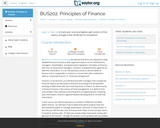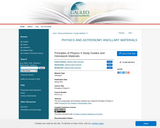
The assessments for this course are available upon request. The test used in this course is Concepts in Biology by OpenStax
- Subject:
- Biology
- Material Type:
- Activity/Lab
- Homework/Assignment
- Lecture
- Author:
- Christa Bowser
- Date Added:
- 06/30/2022

The assessments for this course are available upon request. The test used in this course is Concepts in Biology by OpenStax

In this course, you will be exposed to a number of different sub-fields within finance. You will learn how to determine which projects have the best potential payoff, to manage investments, and even to value stocks. In the end, you will discover that all finance boils down to one concept: return. In essence, finance asks: ŇIf I give you money today, how much money will I get back in the future?Ó Though the answer to this question will vary widely from case to case, by the time you finish this course, you will know how to find the answer.

This course will illustrate the ways in which the practice of management evolves as firms grow in size. Historically, middle managers have served as so-called ŇgatekeepersÓ who collect, analyze, and pass information up and down the management chain within an organization. But two recent developments at the turn of the 21st century Đ namely, low-cost data manipulation in computers and the emergence of widespread, real-time communication (in the forms of inexpensive, long-distance global calling, email, text messaging, and social media) Đ have reduced the need for these middle-manager gatekeepers, and companies have eliminated thousands of such positions. The goal? To speed the flow of information and decision-making and reduce the number of layers that separate the customer from the leadership of an organization.

In this course, you will learn about the marketing process and examine the range of marketing decisions that an organization must make in order to sell its products and services. You will also learn how to think like a marketer, discovering that the focus of marketing has always been on the consumer. You will begin to ask, ŇWho is the consumer of goods and services?Ó What does the consumer need? What does the consumer want? Marketing is an understanding of how to communicate with the consumer.

This course is designed to develop an understanding of the essentials of nutrition in regard to general health, prevention of disease and the functions of nutrients in body building. Emphasis will be placed on nutritional requirements for individuals in different stages of development, proper food selection, preparation and specific nutritional problems of our times.

This course is designed to develop an understanding of the essentials of nutrition in regard to general health, prevention of disease and the functions of nutrients in body building. Emphasis will be placed on nutritional requirements for individuals in different stages of development, proper food selection, preparation and specific nutritional problems of our times.

This set of study guides and homework materials was created for Principles of Physics II under a Round Six ALG Textbook Transformation Grant.

This set of study guides and homework materials was created for Principles of Physics I under a Round Six ALG Textbook Transformation Grant.

Explores the interaction of radiation with matter at the microscopic level from both the theoretical and experimental viewpoints. Emphasis on radiation effects in biological systems. Topics include energy deposition by various types of radiation, including the creation and behavior of secondary radiations; the effects of radiation on cells and on DNA; and experimental techniques used to measure these radiation effects. Cavity theory, microdosimetry and methods used to simulate radiation track structure are reviewed. Examples of current literature used to relate theory, modeling, and experimental methods. Requires a term paper and presentation. The central theme of this course is the interaction of radiation with biological material. The course is intended to provide a broad understanding of how different types of radiation deposit energy, including the creation and behavior of secondary radiations; of how radiation affects cells and why the different types of radiation have very different biological effects. Topics will include: the effects of radiation on biological systems including DNA damage; in vitro cell survival models; and in vivo mammalian systems. The course covers radiation therapy, radiation syndromes in humans and carcinogenesis. Environmental radiation sources on earth and in space, and aspects of radiation protection are also discussed. Examples from the current literature will be used to supplement lecture material.

The aim of this course is to introduce the principles of the Global Positioning System and to demonstrate its application to various aspects of Earth Sciences. The specific content of the course depends each year on the interests of the students in the class. In some cases, the class interests are towards the geophysical applications of GPS and we concentrate on high precision (millimeter level) positioning on regional and global scales. In other cases, the interests have been more toward engineering applications of kinematic positioning with GPS in which case the concentration is on positioning with slightly less accuracy but being able to do so for a moving object. In all cases, we concentrate on the fundamental issues so that students should gain an understanding of the basic limitations of the system and how to extend its application to areas not yet fully explored.

In this course, students identify issues in educational or other professional settings on which to focus their critical and creative thinking skills. Each student works through the different stages of research and action - from defining a manageable project to communicating findings and plans for further work. Supervision is provided when the student's research centers on new teaching practices, workshops in the community, or volunteer. The classes run as workshops in which students are introduced to and then practice using tools for research, writing, communicating, and supporting the work of others.

The professional world can be full of challenging situations, including conflicting personalities, miscommunication, and cultural differences. In this course, you will learn about typical workplace etiquette protocols, communication standards, and cultural awareness strategies in order to navigate these common obstacles as smoothly as possible.

This course is designed to provide adult learners with the basic skills they need to write effective documents in the workplace.

This course will walk you through the nuts and bolts of project management. From understanding the project life cycle to setting priorities and expectations to controlling expenses and reporting results, project management touches several resources within organizations. You will examine roles and environments and various techniques of planning, evaluation, and control. An overview of the tools used in contemporary project management will also be discussed throughout the course.

This course will help prepare you to conduct public relations suitable for small start-up businesses, international companies, political campaigns, social programs, personal development, and other outreach projects.

The purpose of this course is to systematically examine the elements and factors which result in an effective speech. Tying these together are the themes of information and ethics, emphasized in each resource because they are becoming increasingly important to all communicators. Upon successful completion of this course, students will be able to: resolve ethical issues involving speech preparation and presentation; recommend techniques for resolving issues, which may interfere with active listening; identify the most effective speech topics, qualities, content, and delivery techniques based on the specific characteristics of an audience; evaluate the effectiveness of speeches for different types of audiences; use online and library-based research to find and critique the credibility of sources of information; cite sources of information appropriately, accurately, and clearly in both spoken and written contexts; choose the most effective pattern of organization for presenting different types of information to a listening audience; evaluate the effectiveness of supporting details or evidence based on the main ideas or arguments they are used to support; choose the most appropriate pattern for organizing a persuasive speech, based on the relationship between arguments and evidence or the relationship between the topic and the audience; identify whether the functions of an introduction or conclusion have been fulfilled and will be effective when presented to a specific type of audience; create keyword and sentence outlines for informative and persuasive speeches; revise a passage written for readers so that it can be delivered effectively and engagingly to listeners; identify and use techniques to improve the fluidity and clarity of verbal delivery; recognize non-verbal techniques that communicate the speakerĺÎĺ_ĺĚĺ_s confidence and credibility in a sample speech; demonstrate comprehensive knowledge of effective, ethical public speaking by accurately and thoroughly assessing the qualities of entire informative, persuasive, and special occasion speeches. This free course may be completed online at any time. (Communication 101)

This course assists students in developing oral communication skills. Students will be able to speak effectively and comfortably to audiences; explain the nature, value, and requirements of effective public speaking; speak effectively to groups in an academic environment; speak effectively to groups in a non-academic environment; apply principles of cultural diversity to public speaking; and, employ effective information literacy techniques in public speaking.Login: guest_oclPassword: ocl

Python Programming

Selection of aural Italian grammar lessons (podcasts). Grammar examples and dialogs are built upon the escapades of Arlecchino, Pulcinella, and other masks of the Italian Commedia dell'arte. Lessons feature topical grammar discussions, dramatic readings, pdf grammar notes ... and general audio zaniness.

The Read Arabic! Internet lessons were developed at the National Foreign Language Center (NFLC) at the University of Maryland primarily with high school students of Arabic in mind; however, the materials can also be used for those in college at the basic and intermediate level as well. The website assumes knowledge of the Arabic alphabet and how to read. In addition to lessons, the website includes a basic overview of the Arabic language in English, from its history to modern usage, and learning suggestions.